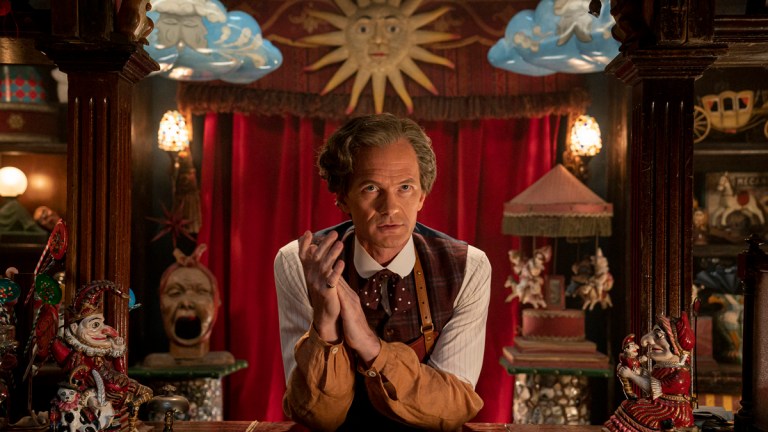Want to Watch The Toymaker’s Original Doctor Who Episodes? Sorry, Not Possible!
Neil Patrick Harris’ Toymaker character is such a deep cut for Doctor Who’s 60th anniversary specials that you can't even watch his 1960s story now.

The new trailer for the Doctor Who anniversary specials has dropped, and with it the reveal that Neil Patrick Harris is going to be playing the specials’ Big Bad – The Toymaker. Many fans had already guessed this was coming, because Doctor Who fans have a sixth sense for determining precisely which camp villain in an elaborate outfit has trapped the Doctor in an elaborate mind game of his own devising.
But for those of us who can’t take one look at Neil Patrick Harris in a top hat and tails and immediately determine that he isn’t the Mind Robber or the Dream Lord or the War Lord or the Meddling Monk or a gender-flipped incarnation of the Rani or whoever Jinkx Monsoon is playing next season, a bit of explanation might be in order.
A bit of explanation and a lot of saying ‘Obviously, Doctor Who is 60 years old and things change and some elements that were of its time when broadcast are completely unacceptable now…’
So let’s get on with it.
“The Toymaker” is a villain from the First Doctor (William Hartnell)-era story, “The Celestial Toymaker”, broadcast in 1966.
Where Can I Watch the Original Episodes?
You can’t. They don’t exist. Even Russell T Davies, if he has seen the story that originated the character, did so when he was two years old.
While these days we assume high-definition recordings of all episodes of Doctor Who are immediately stored in a lead-lined, underground vault not dissimilar to the Svalbard Global Seed Vault, the BBC was not always so precious with its recordings.
Repeats were uncommon, the home video market was non-existent, and recordings of old episodes of a children’s TV programme were mainly just taking up space. So, much like a modern-day streaming service in search of a tax break, the BBC ditched them. The tapes were recorded over and lost forever. Of William Hartnell and Patrick Troughton’s 253 episodes of Doctor Who filmed during the show’s original run, 106 were lost or recorded over in this way, and even today 97 episodes are still missing, although the search continues.
One such story was “The Celestial Toymaker”, the serial in which Neil Patrick Harris’s character originates. Of the four episodes, three are lost, with the final episode allegedly only surviving because its title “The Final Test” led to it being filed with Cricket footage by an Australian broadcaster.
Of course, Doctor Who fans being what they are, “The Celestial Toymaker” has not been completely expunged from existence. To begin with, there is the novelisation by Target Books, which for years was fans’ only way of reliving old stories after they were originally broadcast. Released in 1986, the book was based on the original scripts for the episode, including some material that never made it to film.
But even beyond that, it was not unknown for fans to record the audio of an episode to listen back to later, and that audio has been remastered and released on CD and vinyl with bridging narration by Peter Purves, the actor who played First Doctor companion Steven.
This handily allows Purves to talk over a plot point that revolves around the children’s rhyme “Eeny-Meeny-Miny-Moe”. The old version. No, not that one. The other one. Obviously, Doctor Who is 60 years old and things change and some elements that were of its time when broadcast are completely unacceptable now.
Who is The Celestial Toymaker and What Happens in the 1966 Story?
Detailed plot summaries of Doctor Who episodes are easy to find here on the Internet, but the high points of the story are: the Doctor is invisible following a cliffhanger at the end of the previous episode “The Ark”, which you can still find on DVD. (Controversially, there were plans to have the Doctor become visible with a completely different appearance, before it was decided that audiences would never accept the show recasting its main character.)
The Doctor’s invisibility, it turns out, is the result of a mysterious and powerful entity dressed as a…
Right, okay, let’s do this.
…dressed as a Chinese Mandarin. Obviously, Doctor Who is 60 years old and things change and some elements that were of its time when broadcast are completely unacceptable now.
This figure, who then pulls some clown dolls from a dollhouse and has them grow into full-sized clown footsoldiers, is revealed to be the Celestial Toymaker, an old adversary of the Doctor.
Celestial, because he’s in space, right?
No! “Celestials” was an old-timey slur for Chinese people.
Obviously, Doctor Who is 60 years old and things change and some elements that were of its time when broadcast are completely unacceptable now.
Anyway, the Toymaker is an evil force who captures people and turns them into his playthings. He forces the Doctor and his companions to compete in a series of deadly games, a bit like Squid Game or the later Patrick Troughton Doctor Who Story, “The Mind Robber”, only the theme is toys rather than characters from fiction.
The Toymaker’s motivation is that he has encountered the Doctor before, and wants to trap him in his realm so that he will have a mind as brilliant as his own to play against. With games like hopscotch. I mean, I’m sorry, I love a comic player of games as much as the next nerd, but this guy only uses a six-sided dice. He’s an amateur.
Eventually, the Doctor outwits the Toymaker and escapes in the TARDIS, then eats a sweet and breaks his tooth, a cliffhanger that will lead into “The Gunfighters”, which is tragically still available to watch today.
Doctor Who has had worse adventures, quite a few worse adventures, but it has also had many better ones.
What Makes the Toymaker’s Return So Exciting
Russell T Davies was able to turn Doctor Who into an actual media behemoth largely because he’s as big a nerd as any of us, but at every step of the way he turns against the fan-ish instinct. He holds back on the recognisable monsters, he asks you to fall in love with new characters rather than trotting out the old ones, he will pluck a cool concept from a 40-year-old episode and gleefully ignore all of its surrounding continuity to use the bit he wants to for a story.
So, if you aren’t a fan fully submerged in the lore, the Toymaker seems like a bit of a weirdly deep cut for him to make for the show’s 60th anniversary specials. Then again, he’s bringing back Beep the Meep from the 80s comics, so maybe this incarnation of Davies simply has no more fucks left to give.
But let’s assume for a moment that Davies isn’t making this part of an evil master plan to make the Disney Corporation pay for a big-budget recreation of “The Dominators”. What does the Toymaker have to offer?
As we’ve already said, Doctor Who loves a camp villain in an elaborate outfit who has trapped the Doctor in an elaborate mind game of his own devising. But if we trace that trend back, past Roger Delgado’s debut as The Master with Jon Pertwee, past Patrick Troughton’s numerous genius madmen, there is an argument to be made that the Toymaker is the first Doctor Who villain to really position themselves as the Doctor’s intellectual equal.

Oh, there’s the Monk from “The Time Meddler”, who turned up with his own TARDIS and was the first of the Doctor’s own people we met aside from the Doctor and his granddaughter Susan, but he’s hardly mastermind material. He’s a comic foil, Del Boy with a time machine.
The Toymaker is not only the Doctor’s intellectual equal, but he hints that he and the Doctor have a history. Marking him out as possibly the Doctor’s first non-pepper pot-based arch nemesis.
This isn’t even the first attempt to bring him back for the TV show – Colin Baker’s Sixth Doctor was to have faced off with the Toymaker, played once again by the original actor Michael Gough, in Blackpool, before the show’s production was put on hiatus.
And that is only the beginning.
You see, Doctor Who, the television series, is only the tip of an iceberg of comics, audio plays, novels, RPGs, video games and stage plays whose connections are so complex that they make mere time travel seem pretty straightforward.
The pre-hiatus episode mentioned above, “The Nightmare Fair”, has been adapted as a Target novelisation and a Big Finish audio play – which features the same “Mandarin” outfit on the cover. Obviously, that was in 2009 and things change and some elements that were of its time when released are completely unacceptable now.
The character has also appeared in two other audio stories, two other novels, five short stories, three comic stories and one “Spot the Difference” in the latest Doctor Who annual, where he was named only “The Toymaker”.
But as we’ve already said, Davies’ strength has always been sifting through the giant, messy, often problematic, ahem, toybox that is Doctor Who’s history and picking out the bits that work (and sometimes giving them a European accent for a less racist, orientalist makeover). And the fact is that a cosmically powerful toymaker with a personal grudge against the Doctor is still a strong stand-alone concept.
It’ll be interesting to see what he does with it – so long as it isn’t bringing back the old outfit.
Doctor Who returns on BBC One, BBC iPlayer and Disney+ this November.
